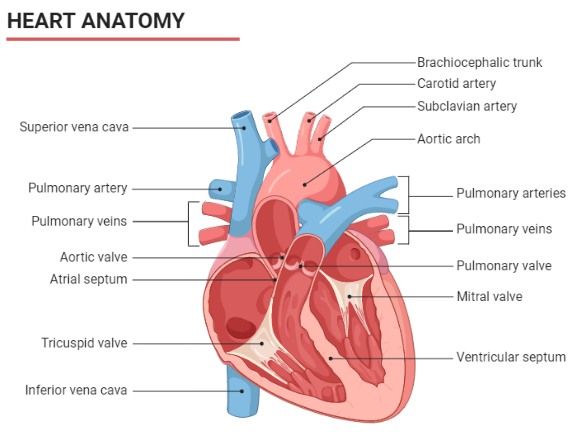
Answer
399k+ views
Hint: One such organ that is inferred mesodermally is the human heart. The pericardium is a two-layered film that covers and protects this human heart. The heart is a double pumping organ in the human body.
Complete answer:
The heart is a hollow cone-shaped organ. It's about the size of the proprietor's closed clenched hand and weighs between 250 and 350 grammes in females and 300 to 350 grammes in males. The heart is located in the thoracic hole, which is located between the lungs (mediastinum) and the vertebral section, leading to the sternum. There are four chambers in the heart.

Septum divides the heart into four parts on the inside.
The atria are the two upper parts, and the ventricles are the lower parts. The atrial septum separates the two atria from one another, and the ventricular septum separates the right and left ventricles.
Deoxygenated blood in the right side of the heart is prevented from mixing with oxygenated blood in the left half of the heart by the atrial and ventricular septum’s walls of the ventricle are typically thicker than the walls of the atrium. The largest vein is the aorta, which emerges from the left ventricle and delivers blood to all of the body's organs. The respiratory conduit, which emerges from the right ventricle, transports deoxygenated blood to the lungs.
The right atrioventricular opening connects the correct chamber and the right ventricle.
The left atrioventricular gap connects the left chamber and the left ventricle.
The tricuspid valve keeps an eye on the auriculoventricular opening, while the mitral or bicuspid valve keeps an eye on the left atrioventricular gap.
Note:
The heart's base is located along the midline of the body, with the peak emphasising the left side. Because the heart focuses on one side, roughly two-thirds of the heart's mass is found on the left half of the body, with the remaining one-third on the right.
Complete answer:
The heart is a hollow cone-shaped organ. It's about the size of the proprietor's closed clenched hand and weighs between 250 and 350 grammes in females and 300 to 350 grammes in males. The heart is located in the thoracic hole, which is located between the lungs (mediastinum) and the vertebral section, leading to the sternum. There are four chambers in the heart.

Septum divides the heart into four parts on the inside.
The atria are the two upper parts, and the ventricles are the lower parts. The atrial septum separates the two atria from one another, and the ventricular septum separates the right and left ventricles.
Deoxygenated blood in the right side of the heart is prevented from mixing with oxygenated blood in the left half of the heart by the atrial and ventricular septum’s walls of the ventricle are typically thicker than the walls of the atrium. The largest vein is the aorta, which emerges from the left ventricle and delivers blood to all of the body's organs. The respiratory conduit, which emerges from the right ventricle, transports deoxygenated blood to the lungs.
The right atrioventricular opening connects the correct chamber and the right ventricle.
The left atrioventricular gap connects the left chamber and the left ventricle.
The tricuspid valve keeps an eye on the auriculoventricular opening, while the mitral or bicuspid valve keeps an eye on the left atrioventricular gap.
Note:
The heart's base is located along the midline of the body, with the peak emphasising the left side. Because the heart focuses on one side, roughly two-thirds of the heart's mass is found on the left half of the body, with the remaining one-third on the right.
Recently Updated Pages
Who among the following was the religious guru of class 7 social science CBSE

what is the correct chronological order of the following class 10 social science CBSE

Which of the following was not the actual cause for class 10 social science CBSE

Which of the following statements is not correct A class 10 social science CBSE

Which of the following leaders was not present in the class 10 social science CBSE

Garampani Sanctuary is located at A Diphu Assam B Gangtok class 10 social science CBSE

Trending doubts
A rainbow has circular shape because A The earth is class 11 physics CBSE

Which are the Top 10 Largest Countries of the World?

Fill the blanks with the suitable prepositions 1 The class 9 english CBSE

What was the Metternich system and how did it provide class 11 social science CBSE

How do you graph the function fx 4x class 9 maths CBSE

Give 10 examples for herbs , shrubs , climbers , creepers

The Equation xxx + 2 is Satisfied when x is Equal to Class 10 Maths

What is BLO What is the full form of BLO class 8 social science CBSE

Change the following sentences into negative and interrogative class 10 english CBSE




